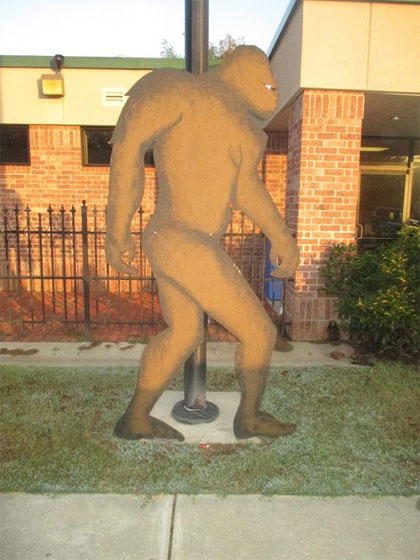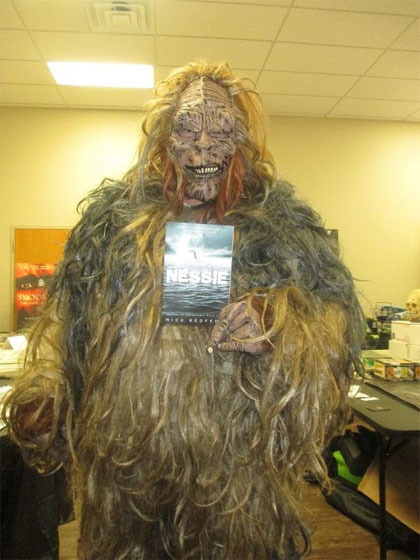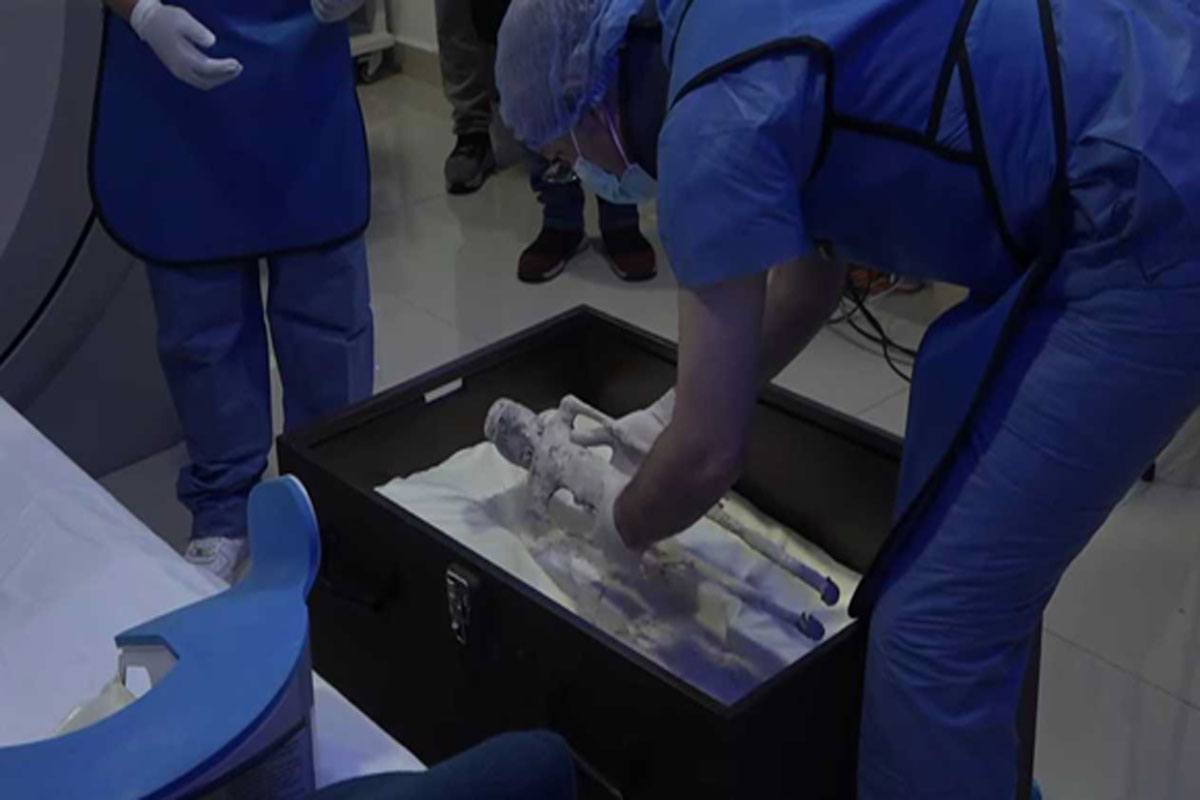
Five of the Most Dangerous, and Monstrous, Humanoids Out There: Beware!
Nick Redfern January 27, 2022
At times, the field of Cryptozoology can be a violent one. Occasionally, a deadly one. With that said, let’s have a look at some of the most dangerous monsters out there. We’ll begin with the Nyalmo. You may not have heard of that one. It is, however, a form of Yeti (also known as the Abominable Snowman). The Nyalmo, though, is a creature that should not to be approached. As legendary cryptozoologist Bernard Heuvelmans said: “The Nyalmo are real giants, between 4 and 5 m high, with enormous conical heads.” He continued: “They wander in parties among the eternal snows above 4000m. In such empty country it is hardly surprising that they should be carnivorous and even man-eating [italics mine].” Heuvelmans asked of the Nyalmo: “Do they really exist, or are they just a myth?” He admitted to having heard of accounts of Yetis with feet around 45 to 60 cm in length, but was careful to qualify this by stating that: “…the evidence is far too slender for us to draw any satisfactory conclusions. Possibly the Nyalmo are an invented addition based on the belief that yetis increase in size the higher you go.” Now, there is the equally dangerous beast, the Kushtaka.
 (Nick Redfern) What lurks in the mountains?
(Nick Redfern) What lurks in the mountains?
In 2014, one of the most intriguing Bigfoot-themed books was published. The author was Dennis Waller. The title of his book was In Search of the Kushtaka: Alaska’s Other Bigfoot. This is an excellent read for anyone fascinated by cryptozoology in general and Bigfoot in particular. Waller’s title is not your average Bigfoot book. And that’s not a bad thing at all. As the book demonstrates time and again, the Kushtaka phenomenon is not just strange. Simply put: it’s very often downright too strange. We never, ever, find a body. The beast is seemingly impervious to bullets. There are reports of the creatures vanishing before the witness – and by “vanishing” I do mean that literally. There is, however, something very strange about the Alaskan beast. It has astounding abilities, including the power to seemingly vanish (and reappear) at will, to shape-shift, to take on the guise of a deceased person, and to engage in telepathic communication. It can also manipulate space and time. Many might be inclined to relegate such tales and claims to the worlds of folklore and myth-making – and all without giving matters any degree of second thought.
 (Nick Redfern) On the road
(Nick Redfern) On the road
Waller takes us on a fascinating journey that does not deny the legends and folklore that have become part of the Alaskan Bigfoot puzzle. It is, however, a journey that – to make its point – also encompasses science. On this latter issue, Waller delves deeply into the domain of String Theory, quantum physics, and multiple-dimensions. In other words, ancient legend may have been borne out of a science that – to a significant degree – still very much eludes us to this day. It’s also a science that spills over into the realms of Shamanic activity, altered states of mind, the afterlife, and creatures that very possibly feast on human life-energy [italics].
Now, it’s time to take a look at the Wendigo. A terrifying thing that appears prominently within the lore of the Algonquin people – the most widespread and populated of the Native American groups, with tribes originally numbering in the hundreds – the Wendigo is an evil, cannibalistic, and rampaging creature with the ability to possess human sous and minds [italic mine], forcing them to do their dark bidding. Humans have the ability to transform into a Wendigo, especially if they have engaged in cannibalism. Notably, in centuries past, those who were suspected by the Algonquion of being Wendigos were decapitated after death, to prevent them from rising from the grave and going on slaughtering, people-eating rampages. Many of the reports of the Wendigo are focused around large forests, freezing cold and wintery environments, and dark woods. In light of that, there is a theory that the stories of the Wendigo are the result of (a) a distortion of real events, involving Native Americans who were forced to resort to cannibalism when food was scarce in the winter months; and (b) tales told to try and dissuade people from cannibalism, by making them think that eating human flesh would turn them into Wendigos. Now, let’s look at Bigfoot.
It’s not every day that a U.S. president makes comments and observations on Bigfoot. But, as incredible as it may sound, President Theodore Roosevelt may have done exactly that in the pages of his 1890 book, The Wilderness Hunter. The president, who was also a keen hunter and an avid outdoors-man, told a story that sounds eerily, and chillingly, like a close encounter with a killer-Bigfoot. An extract from his amazing, more than a century old, story follows: “Frontiersmen are not, as a rule, apt to be very superstitious. They lead lives too hard and practical, and have too little imagination in things spiritual and supernatural. I have heard but few ghost stories while living on the frontier, and those few were of a perfectly commonplace and conventional type. But I once listened to a goblin-story, which rather impressed me. A grizzled, weather beaten old mountain hunter, named Bauman who, born and had passed all of his life on the Frontier, told it the story to me. He must have believed what he said, for he could hardly repress a shudder at certain points of the tale; but he was of German ancestry, and in childhood had doubtless been saturated with all kinds of ghost and goblin lore.”
 (Nick Redfern)
(Nick Redfern)
Roosevelt added: “So that many fearsome superstitions were latent in his mind; besides, he knew well the stories told by the Indian medicine men in their winter camps, of the snow-walkers, and the specters, [spirits, ghosts & apparitions] the formless evil beings that haunt the forest depths, and dog and waylay the lonely wanderer who after nightfall passes through the regions where they lurk. It may be that when overcome by the horror of the fate that befell his friend [italics mine], and when oppressed by the awful dread of the unknown, he grew to attribute, both at the time and still more in remembrance, weird and elfin traits to what was merely some abnormally wicked and cunning wild beast; but whether this was so or not, no man can say.” According to Roosevelt, the mysterious creature attacked Bauman’s friend and “…broke his neck by wrenching his head back with its fore paws, while it buried its teeth in his throat [italics mine]. It had not eaten the body, but apparently had romped and gamboled around it in uncouth, ferocious glee, occasionally rolling over and over it; and had then fled back into the soundless depths of the woods.”
Finally, we’re about to focus on a monster that first surfaced in very strange ways – and not too long ago: the Slenderman. Imagine the scene: it’s the dead of night and you are fast asleep. Suddenly, though, things change radically and you find yourself far from asleep: you are now wide awake but unable to move. You are completely paralyzed. You try and cry out but it’s no use. Your heart pounds and your head spins chaotically. Worse still, you see hunched over in the shadows of the bedroom an eight-to-nine-foot-tall, skinny and emaciated creature. It is dressed in an old-style black suit, has a pale face that lacks eyes, a nose, ears and a mouth. As for its arms and legs, they are almost like those of a spider: long, thin and spindly. Rubbery, octopus-like tentacles protrude from its torso; they wave and flicker ominously in your direction. To your horror, the night-fiend slowly moves toward you and leans over. Its foul breath makes you wretch. It whispers that you are about to die. Or, that it is coming to take your soul. Maybe you will be its eternal slave in its forested, ancient abode. Now in a state of complete terror, you finally manage to cry out and wake up in a cold sweat. The terrible thing is suddenly gone. You have just had a trauma- and fear-filled encounter with the Slenderman.
 (Nick Redfern) A modern day monster
(Nick Redfern) A modern day monster
The Slenderman had a strange start: he began “life” purely as an Internet creation, specifically the work of a man named Eric Knudsen. In June 2009, Knudsen, via the pseudonym of “Victor Surge,” uploaded a couple of doctored photos of the Slenderman to the forum of the Something Awful website. In no time at all, others began writing – and posting online – their very own tales of the Slenderman. Short stories, blogs, novels, online games, chat-rooms, and more soon followed. Then, something menacing and sinister happened: people, all across the world, began to see the Slenderman. Not just on the Internet, not in novels or in the pages of comic-books, but in their homes. In their bedrooms. In mysterious woods. In dreams that rapidly escalated into full-blown nightmares. The Slenderman came to life in the form of a Thought-Form. All of the five monsters above are very different creatures. There is, however, one connection between them all: they should be avoided at all costs.



















